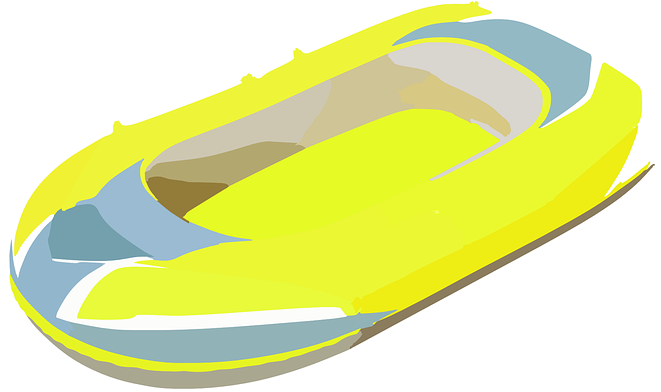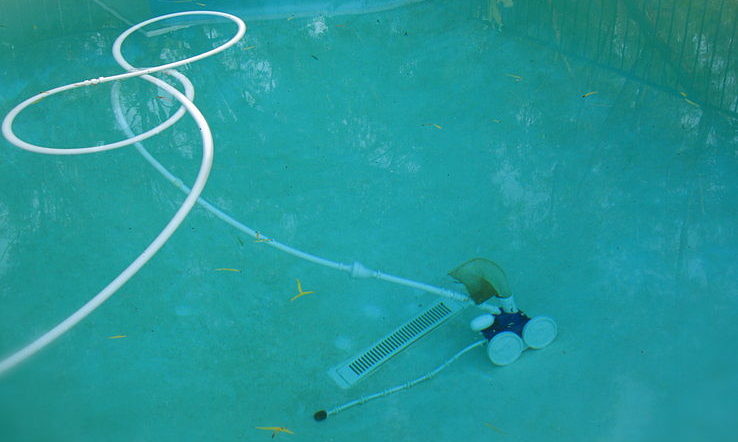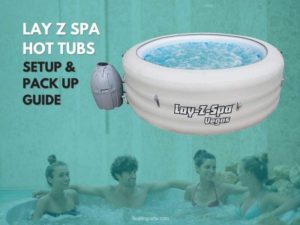Having a pool brings so much fun into the house. You can lie on the poolside, or be on the water in a pool float; it’s a relaxing experience. There was a time when having a pool was considered a luxury, and now it’s a household essential.
But having a pool comes with a lot of added responsibilities. To enjoy the pool properly, you have to keep it clean and well-maintained. A dirty pool not only is a major mood killer, but it’s also a health hazard.
That’s why keeping your pool in good condition is essential.
See also:
- Clean Your Pool Floats Like A Pro in 3 Simple Steps
- Best Inflatable Pool Swimming Pools For Adults!
- Best Spring Pool Floats for Kids and Adults
- Best Pool Floating Loungers
One way to go about cleaning the pool is getting cleaning supplies and doing the hard work with your own hands. That can take some time. Also, it can be tiring if you’re not used to it. You can also pay a professional as well if you want. But, what if there was a way that required no effort from you?
Enter Automatic pool cleaner!
As the name suggests, an automatic pool cleaner is a solution to all your pool cleaning needs. There are primarily three types of automatic pool cleaners; Pressure side, suction side, and robotic. But first, let’s discuss a bit about swimming pool circulation.
WHAT IS SWIMMING POOL CIRCULATION?
A good understanding of swimming pool circulation is essential for getting the proper idea about automatic pool cleaners. Based on the type of automatic pool cleaner, the chemistry changes between the pool cleaner and the pool circulation, and filtration system.
All pools (above, or in the ground) have a proper system to keep the water in motion, and filtered. It’s there to keep the water clean for swimming. Stagnant water loses its freshness and quickly becomes unfit for swimming.
Thanks to the pool circulation system which starts at the skimmer and ends at the jet (or jets), the water is always in motion. At the skimmer, the water is sucked out. This water now ends up at the water jet and is pumped back in.
The water is delivered to the pool filter through some pipes after it is pulled into the skimmer by the pump. All the sediment and gunk that the water contains is filtered here, and then fresh water is pumped back into the pool through the pipe, via return water jet/s.
Running the pump all day keeps the water as fresh as possible. But that is not very economical, so twelve hours a day is a safe option. In this duration, the pool water can be turned at least once.
NOW, LET’S GET TO THE AUTOMATIC POOL CLEANERS TYPES
SUCTION- SIDE POOL CLEANERS
The part of the filtration system which pulls the water out of the pool is called the suction side.
Suction side pool cleaners are the economical solution for pool cleaning. It can usually cost you around $100 to $400.
These cost less to own and operate, but these rely on the pool filter to clean the water. Because of this, the pool filter needs more care.
HOW DOES IT WORK?
The suction side pool cleaner is attached to the skimmer or the dedicated suction line. For the suction side cleaners to work, the water pump needs to be running.
Once that’s done, it moves around the pool, slowly sucking up debris and gunk, and sends it to the filtration unit. The size up to which these will clean depends on the model you’re buying. Mostly, these cleaners pick medium debris, but some models can also pick up smaller pieces.
Some of the models lay flat against pool floor with the help of the rubber disks, while others have wheels. Some can even climb the walls of the pool.
Depending on your pool type and wall finish, you can select the right model for the maintenance of your pool.
HOW TO INSTALL (AND USE) THE SUCTION SIDE CLEANER?
By following a few simple steps, you can keep your pool clean. To install the suction side cleaner, here’s what you need to do –
- Begin by turning off your pump. Once that’s done, vacuum your pool. Then clean your filter and pump basket.
- You need to clear the lines after cleaning so next, run your pump for five minutes. Afterward, shut it off.
- Now, after you’ve closed the pool main drain line, aim the return lines downward.
- Inside the skimmer suction port, install the wall fitting to your return line (or valve assembly).
- Lay the hose across your pool from the return line or skimmer, to the farthest pool wall. Adjust the length by trimming the excess hose parts.
- After attaching the leader hose to the pool cleaner end, submerge it to allow it to fill it with water.
- Now, submerge the pool cleaner as well so that it can also fill with water.
- Install your model’s flow regulator valve (if it has one) to the hose, and attach the leader hose to your pool cleaner.
- After the pool cleaner has reached the pool floor, you can turn on the pool pump. Your suction side cleaner will now begin its function.
By using the suction side cleaner throughout (or multiple times) a week, you can ensure the cleanliness of your pool.
MAINTENANCE AND STORAGE
With proper care and attention to details, you can easily maintain your suction side pool cleaner to enjoy its benefits for a long time. All you need to do is to keep a few things in check such as –
1. In case the cleaner is unstable, you should check the pressure. While the pump is running, hold the pool cleaner just below the water surface. By using flow gauge, or counting the wheel rotations (depending on your model), adjust the pressure (as per your pool cleaner specifications).
2. To keep the hose kink free clean it, and lay it straight flat in the sun. While storing, store it flat.
While storing the cleaner in the winters, disconnect all the hoses and connectors. After cleanup, drain all the water from hoses and cleaner and lay the hoses flat. Keep the same in mind while storing the disc (if you have a disc cleaner). Always store the parts away from sunlight.
After suction side pool cleaner, let’s discuss the next automatic pool cleaner on the list –
PRESSURE SIDE POOL CLEANER
Pressure side pool cleaner is probably one of the most popular of the three automatic pool cleaner types. If you’re looking to clean medium to larger sized debris, the is the one you want.
You can purchase these cleaners across a wide price range. Generally, these fall between the price range of $200 to $900. As the price goes up, features like rubber wheels, better wall grip, and zipper filter bags are included.
Which model is right for, depends on the specification of your pool. If your pool requires high maintenance, you can go up the price range, otherwise, the lower range models do an adequate job.
HOW DOES IT WORK?
This type of pool cleaner attaches to the return jet/s in your pool. By using the water pressure, this cleaner moves around the pool. It usually cleans medium to large sized debris.
Pressure side cleaners include wheels, a sweep hose, a return jet hose, and a filter bag.
After installation, the pool pump pushes water through a hose to jets located underneath the pool cleaner, right along the sweep hose. Due to these concentrated streams of water, the cleaner moves. At the same time, the debris loosens and is pushed up to the filter bag. Finer particles leave through the filter bag and are cleaned out in the pool filtration system.
If you own an above ground pool, there are quite a few models, designed especially for that. In these models, your pool’s filtration system is used to catch the debris. There is no filter bag, and you should keep clearing out the large debris with hand skimmers to make sure that the pool skimmer is not clogged.
HOW TO INSTALL (AND USE) THE PRESSURE SIDE POOL CLEANER
The installation process is very similar to the suction side pool cleaners, except in some steps. Here’s what you need to do –
- Clean your pool filter and then turn on the pump for five minutes to flush the return line. Afterward, turn the pump off.
- After installing a universal wall fitting into your dedicated return line, or a return jet, trim the leader hose to equal its length to the deepest part of the pool. Then, screw the leader hose into the wall fitting.
- Now, Attach the leader hose to the feed hose. Afterward, extend the feed hose to the farthest pool edge from the return line, across the pool surface. If the feed hose extends the distance, trim it to the proper size using the manufacturer’s recommendations. The typical process involves cutting equal amounts from each section to make adjustments.
- After making sure that all the feed hose floats are evenly placed, connect the feed hose to the pool cleaner, and secure the filter bag.
- Next, you need to prime your pool pump. First, turn your multiport valve to recirculate. After that, fill the pump with water, and turn on the filter system.
- In case you have a booster pump, turn that on.
- You need to ensure that the RPM’s of the cleaner’s wheels are within the recommended range. If it is not correct, it can cause problems. If the RPMs are slow, the pool cleaner will not clean the surface properly. If it’s too fast, the pool cleaner will lift off the floor. That is not good either. So, using the manual, you can set the ideal RPMs for your model. Here’s what you should do –
– Take a marker and draw a line on the tire.
– Submerge the cleaner underwater after turning it on. Set the timer to one minute.
– Count the tire rotations. One tire rotation is when the cleaner returns to the start point.
– Count the RPM, and compare it to the recommended range. If it within the recommended range, you are all set. If not, adjust it until you achieve a good number of RPM.
– After setting up, use the cleaner as needed. At least two times a week is recommended, but you can use it as often as needed.
If you have a pressure side pool cleaner, you should know about these accessories as well –
Booster Pumps
Some pressure side cleaners require more water pressure than some pools can provide. Booster pump helps with this.
The booster pump connects to your pool’s circulation system and boosts the incoming water pressure.
Good water pressure is necessary for the pressure side pool cleaner to function properly. This way, your pool is cleaned in just the right amount of time.
Back up Valve
It is a very tiny part of the system. The backup valve is installed on the feeder hose, away from the cleaner body. It has a very crucial function. The backup valve redirects the pool cleaner and helps clean the entire pool.
The valve starts after a set interval of time. It stops the water flow to the cleaner, and instead, shoots water from the side jet. What this does is, it makes sure that the entire pool is covered. Thanks to the backup valve, you don’t have to worry about any unclean pool parts.
MAINTENANCE AND STORAGE
To keep the pressure side pool cleaner in the best shape, you need to take of it. Regular cleaning and maintenance required to keep the cleaner tip-top. Here’s what you need to do to take care of it –
- Remove the filter bag carefully from the cleaner. Let it dry in the sun for a while. The debris will soon dry up, and you can throw it out.
- If you think the filter bag looks clogged up, spray it properly with a hose to clean it. If you have another filter bag, you can take your time cleaning it properly.
- Next, you need to wash the in-line filter properly with water. You can find it easily inside the filter assembly. After cleaning, place it back carefully.
- Clean your sweep hose and cleaner body. Check your sweep hose for debris and if necessary, hose it down. Also, clear the opening on the end of your sweep hose and your cleaner’s body.
- Checking on all parts of your cleaner time to time is a good idea.
- Don’t over tight the hose connection. DO it with your hands to ensure the proper tightening of the hose. Over tightening can strip the connectors, which is an unwanted outcome.
While storing, rinse the cleaner off and clean the filter and the filter bag properly. Give everything a good sunbath until everything is properly dry. When storing, keep away from direct sunlight.
ROBOTIC POOL CLEANER
Robotic Pool cleaners are great for pool cleaning. They differ slightly from the previous two types. You don’t need to connect them to the pool circulation system at all. Just plug them in, and watch the go. The cool thing about these is, these cleaners can catch debris of any size.
There are also solar-powered robotic cleaners that you can get. They are usually best for cleaning the floor debris. Although, in case of wall scrubbing or vacuuming, they’re not as adequate.
Generally, robotic cleaners cost between $500 to $1000, but you can also find a few models under $500. For features such as Rapid water release, waterline scrubbing, programmable cleaning cycles, and remote control, you are probably going to put in some more money. For general cleaning, however, most of the models are adequate.
HOW DOES IT WORK?
Generally, robotic pool cleaners have long cords. You can easily plug them in, and submerge them into water. You need to plug them into ground fault circuit interrupter (GFCI) outlets, that automatically shut off in case of an electrical imbalance.
There are also “double insulated” models available, which don’t require grounding prong plug. But for safety, you should still plug them into the GFCI outlet.
After you’ve plugged the cleaner in, it drives around your pool vacuuming small, and big debris, along with scrubbing the wall with tiny brushes. Some more expensive models can also clean the water line around your pool as well. These cleaners are not attached to the filtration system and have a filter bag or built-in cartridge for the collection of debris.
HOW TO INSTALL (AND USE) THE ROBOTIC POOL CLEANER
Setting up the robotic pool cleaner is a simple process. The first time is when you need to pay close attention. After that, you can do it easily every time. Here’s what you need to do – First, assemble the cleaner. After that, plug it into the nearest GFCI outlet.
- Next, you have to select the settings for operation. For example, if you want to clean the waterline, there’s waterline only option available in many models. Similarly, for the bottom, there is “Bottom only” option available, and so on. Depending on the outcome you desire, you can set it up.
- You can avoid any cable tangling by bringing your robotic cleaner to the halfway point of your pool length.
- Gently shift the cleaner side to side when you’re submerging it, to let the air escape. Never turn on the leaner outside of water. Make sure it is submerged when you turn it on.
- Now turn on the cleaner and let it sink to the pool bottom.
- If there’s any problem during the wall scrubbing, refer to the manufacturer’s instructions. Especially the first time, keep an eye out for any performance issues.
- When you’re done using the cleaner, turn it off before taking it out of the pool. Always take it out after use instead of leaving it in. Dry it properly before storing it, away from sunlight.
MAINTENANCE AND STORAGE
Taking care of Robotic pool cleaner is not as intimidating as it sounds. It just needs attention to detail and regularity. If you maintain your robotic pool cleaner, you can enjoy its benefits for a long time. Here are a few things to keep in mind about its maintenance –
- After you’ve cleaned your pool, always take out your robotic pool cleaner. Do not leave it inside, and dry it after use.
- Always turn off the power before taking out the robotic pool cleaner. Similarly, first, submerge it, and then turn it on.
- Take the cleaner out of the pool and drain the water out. Afterward, coil the power cord on its holder.
- If you want to avoid kinks in the cleaner’s cord, fold it in the opposite direction once in a while. With time this can happen.
- Always make sure to check on the drive tracks, impellers, and brushes for any lodged debris. If you find it, clean it thoroughly for smooth operation. Make sure to replace the old dull brushes with new ones for maximum performance.
- The filter bag or in-built cartridge and clean it properly. Give it a good wash down.
When you’re done using the cleaner, take it out, and dry it in the sunlight till all the water is gone. Then store it away from sunlight.
WHAT’S THE BENEFIT OF HAVING AN AUTOMATIC POOL CLEANER?
Having an automatic pool cleaner is a relief for pool owners. There are many benefits to having one of the automatic pool cleaners. You can save a lot of time, energy, and money, using these. Here are the most prominent benefits of automatic pool cleaners –
- By using an automatic pool cleaner regularly, you can lessen the load on your skimmer. This way, there is very little for you to clean after.
- Not only do these cleaners clean the pool, but also move the water around so that the water temperature remains proper.
- The use of automatic pool cleaner is also good for the filter as well. It lessens the filter wear.
- You can forget about cleaning the pool manually, which takes up a lot of time and is also require a lot of patience and effort.
Having an automatic pool cleaner can make maintaining your pool very easy, but always be careful. Always take it out before swimming, and when you’re cleaning the pool with chemicals never leave it in. Never turn it on when it’s out of water. Run the pool circulation system for a good five minutes after cleaning the filter. After that, you can hook up the cleaner.
Check all the components after each use. With proper attention and care, these devices can help you in keeping your pool nice and clean for a long time.
Floating Rafts is a website covering best pool floats, tubes rings and floats buyer’s guides.



